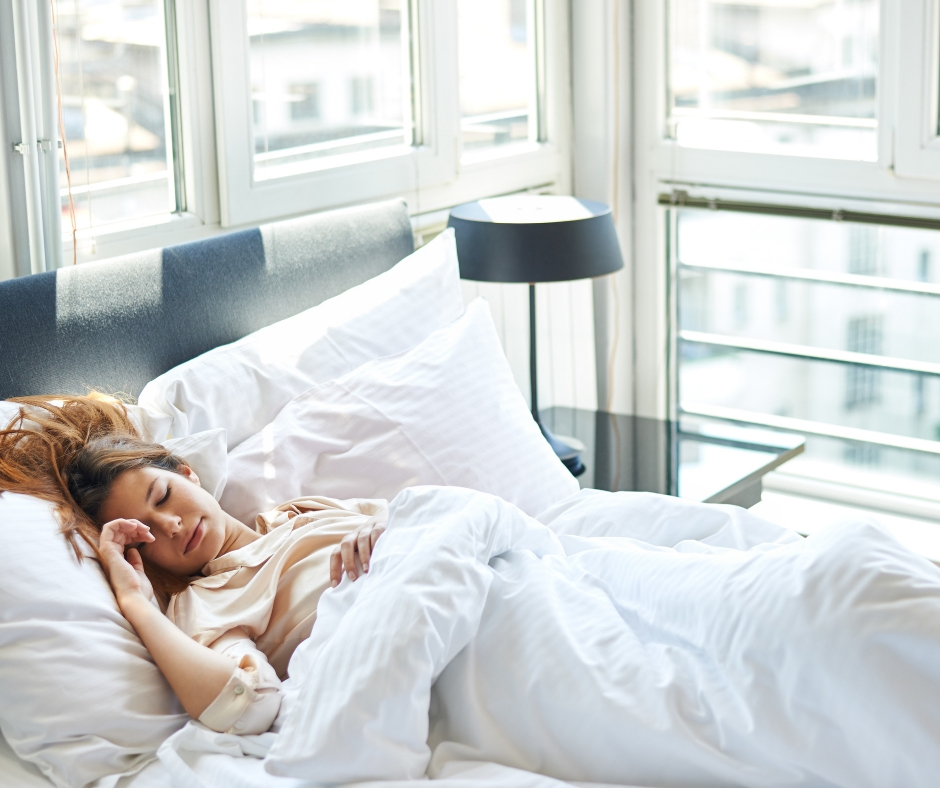Correct Your Posture While You’re Awake
The biggest, most overlooked factor of not experiencing pain during the night – and helping your pain during the day as well – is focus on correcting your posture during the day. Look at how you’re sitting on your commute to work, how you’re sitting at your desk, how your lounging around in the evening etc. All of these things we tend to do for extended periods of the day, and it’s quite common to slouch on the sofa in the evening or sit with the head propped up against some pillows – as equally common as it is to slouch at your desk or sit looking down at your phone for a long time.
Focus on not sitting with bad posture, checking back in with your posture every hour or so at first if that’s what it takes. This can be uncomfortable at first, since your muscles weaken when they’re not being used properly, it can take some time to regain this strength so do persevere and it will become easier. Focus on engaging and strengthening your core during the day, but if you’re finding that it’s difficult to correct your posture then you should be getting treatment to help.
Correct Sleeping Posture
When it comes to sleeping, you need to find a position that is putting the least amount of pressure possible on your back. You’ll commonly find that sleeping on the side is the most effective way and the most comfortable for you as well. The trouble is, usually when people sleep on their side your knees drop it, the glute muscles tighten which then pulls on the lower back. Instead, try popping a pillow between the knees which will open the legs marginally and ease some of that stress which it means it won’t pull as much on the lower back.
It’s also important to be aware of avoiding certain postures with your back during the night in order to not make it worse. A lot of people tend to sleep curled around, which can put a lot of stress and compression through your back and your neck – certainly not something you would want to do long-term. Even if you believe that position is most comfortable for you, it will almost certainly make your back pain worse in the long-run. In the clinic, during our examination process we will usually look at the alignment and natural curves of people’s backs to make sure that when they’re standing they’re in as good a position as possible.
The curve of the spine in our video at the top of the page, is one that ideally we would try to match with a patient, since this curvature gives the spine the most support against daily stresses and strains as well as allowing to distribute force of gravity evenly. This is the position you should be trying to maintain on a daily basis, while you’re awake and asleep. So when you’re lying down try not to curl up into a fetus shape, try and lie in as neutral a position as possible. This means supporting the natural curve of the spine by not bending forwards or backwards, and make sure that your head is also equally supported – not being propped up by too many pillows or equally too low as well. If you’re not sure what kind of pillow to use, check out our guide here.

How To Help Your Back Pain During The Day
The downside with this approach, is firstly most of us are quite active sleepers – meaning the position that you fall asleep in is likely to change very frequently during the night. Even if you try to fall asleep in a way that protects your spine alignment, does not mean that you will stay in that position throughout the night. Unless you’re a very still sleeper, you may find that approach to be less helpful. After all, it can be difficult enough to correct your posture during the day let alone when you’re asleep and not aware for the most part of how you’re sleeping.
The best things you can do that will help you would be to get treatment from a practitioner who takes a thorough approach to examining your spine – down to analysing the position of your spine, using an ice pack (be sure to wrap it in a towel) for 5 minutes at a time multiple times per day to bring down inflammation, not sit at your desk for too long and look at your posture when you’re commuting, sitting at your desk or in the evening. Lastly, before you go to bed have a move around to loosen up your back. When we get home from work we tend to sit down and relax for the rest of the evening, if you’re doing this then your back might be ceasing up before bed which will make sleeping hard. Inflammation can build up while you’re stationary, so just before you sleep try to get up and walk around – avoid anything that involves bending forward or backwards and just do some bits and pieces around the house for 5-10 minutes before going to bed. That can make a big difference to your sleep.
Follow these tips, and if you need any more information on back pain, neck pain or any specific conditions be sure to visit our website for more information. If you’re suffering with back or neck pain and it is affecting your sleep, call our expert team today to see how we can help you. You can get in touch by calling us on 0203 947 3222 or by emailing info@themayfairclinic.com.
Contact Us.
Email Us
info@themayfairclinic.com
Call Us
0203 947 32 22
Clinic Address
4 Cavendish Square, London, W1g 0PG.